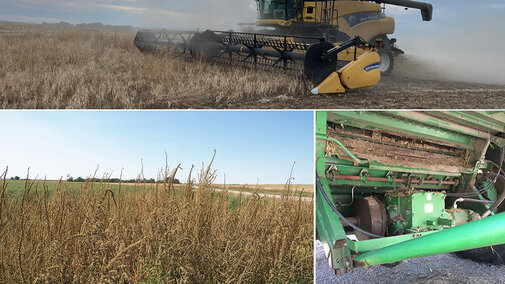With increasing pressure from herbicide-resistant weeds such as kochia and introduced herbicide-resistant weeds such as Palmer amaranth and waterhemp, it is more and more important to reduce spreading of weed seed.
Palmer amaranth (Amaranthus palmeri) and waterhemp (Amaranthus tuberculatus) are recent arrivals to the Panhandle, becoming widespread only in the past few years. Palmer and waterhemp are thought to have spread here from the south and midwest through contaminated grain and cotton seed used for cattle and dairy feed. They have subsequently spread into production fields through manure sourced from dairies and feedlots, according to a 2017 CropWatch article by Nevin Lawrence, integrated weed management specialist at the UNL Panhandle Research and Extension Center.
Palmer Amaranth — Serious Threat
Weed scientists from around the country consider Palmer amaranth a serious threat to crop production.
According to Rich Zollinger, retired extension weed scientist from North Dakota State University, “Palmer amaranth’s prolonged emergence period, rapid growth rate, prolific seed production, and propensity to evolve herbicide resistance quickly makes this the most pernicious, noxious, and serious weed threat that North Dakota farmers have ever faced.”
He said Palmer amaranth is a competitive and aggressive pigweed species that poses a major threat to North Dakota crop production because it grows aggressively (up to 2-3 inches per day in optimum conditions); can grow to 6-8 feet tall; has reduced yield up to 91% in corn and 79% in soybean; is a prolific seed producer (up to one million seeds per plant); emerges throughout the growing season; and is very prone to herbicide resistance (multiple modes of action).
Palmer amaranth poses the same threat in western Nebraska, as we see it increasing every year. In the Panhandle we have seen serious yield losses in dry beans, up to complete field abandonment due to severe Palmer amaranth infestations. It also causes dramatic yield loss in sugarbeets.
Between-field Cleaning Steps
Harvest equipment moving through the fields in the fall at the peak of weed seed production are very likely to move this seed around. Doing a limited cleaning between fields and choosing which fields to harvest first can be an important factor in minimizing weed seed spread.
Here are some steps for cleaning the combine, from the North Central Agricultural and Natural Resources Academy (2017):
- Run the unloading auger after it is empty for at least one minute.
- Open the clean grain and tailings elevator doors, rock trap and unloading auger sump. Make sure all bystanders are at least 50 feet away.
- Start the combine and separator. Adjust the cleaning shoe fan to full speed for maximum airflow. Alternately, open and close cleaning shoe sieves electronically. Also adjust the rotor to full speed for maximum air suction or open and close the concaves. Operate the combine this way for at least two minutes and drive over end rows or rough terrain to dislodge more material for self-cleaning.
- Clean out any material left in the rock trap.
- Try to get the “top” of trapped material in sumps or areas that hold straw, chaff and grain. As you start the next field or crop, it is likely that new material from the next field will fill in these areas as opposed to the remaining material in the bottom of these areas being moved out.
- Use a leaf blower or air compressor to remove material from the exterior of the combine, focusing on the head, feeder house, and axle and straw spreader at the rear of the machine. A shop vac can be helpful to remove materials from some enclosed areas.
- Close the doors to the rock trap and clean the grain elevator and the unloading auger sump.
The areas of the combine holding the most biological residue are the header, feeder house and grain tank. If time is limited, consider cleaning these areas first. From a practical perspective the grain tank under the augers is one of these areas and is very difficult to clean. Top material in this area can possibly be removed with a shop vacuum.
Additional Considerations
Beyond the process of cleaning out the combine between fields, some additional considerations are important. If there are some weeds in your field such as Palmer amaranth and if it is possible to rogue them out or remove them before harvest by hand, the effort would be well worthwhile. If there are large populations of weeds, hand pulling would be impossible.
Another consideration would be to combine weedy fields last and even to cut around a weedy spot in the field and save it until last to minimize spreading the seed.
Also think about where to do this clean-out to avoid creating more problems. Do not do it in a crop field or where other equipment tires might track it back into crop fields. A feedlot area might be good, or the dryland end of a field that gets no irrigation where the weed seed is less likely to germinate. Avoid windy conditions where seed may be blown back into the field or back onto the machine that you have already cleaned.
It will not be possible to totally eliminate the spread of weed seed, but the above measures can help reduce and slow down the spread of noxious weeds. The above between-field cleaning procedures can be done within about a half hour with a few basic items on hand such as a leaf blower and a shop vac. A complete and thorough combine cleaning is required at the season’s end.
See this website for guidelines to a complete combine cleanout.

